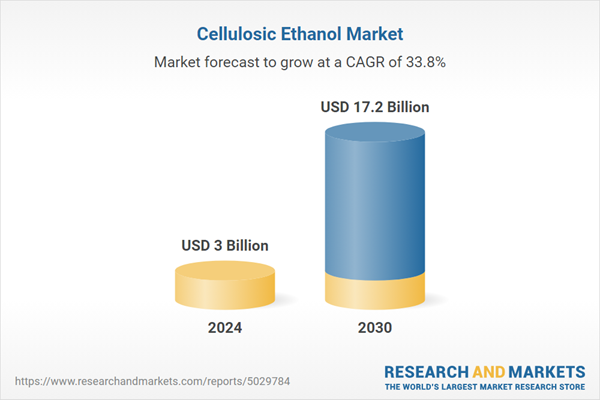The global market for Cellulosic Ethanol was valued at US$3.0 Billion in 2024 and is projected to reach US$17.2 Billion by 2030, growing at a CAGR of 33.8% from 2024 to 2030. This comprehensive report provides an in-depth analysis of market trends, drivers, and forecasts, helping you make informed business decisions.
Global Cellulosic Ethanol Market - Key Trends and Drivers Summarized
How Is Cellulosic Ethanol Becoming a Key Player in the Renewable Energy Transition?
Cellulosic ethanol, a second-generation biofuel produced from non-food-based biomass such as agricultural residues, wood waste, and energy crops, is rapidly gaining importance in the renewable energy landscape. Unlike first-generation biofuels, which rely on food crops like corn and sugarcane, cellulosic ethanol is derived from plant-based waste materials, making it a more sustainable and environmentally friendly alternative. The production process involves breaking down the cellulose found in plant cell walls into sugars that can be fermented into ethanol. Although the process is more complex than that of conventional ethanol production, significant technological advancements have improved its efficiency, making cellulosic ethanol a viable option for reducing greenhouse gas emissions. Its potential to utilize low-cost, readily available waste materials has attracted significant attention from governments and industries looking to decarbonize the transportation sector. As more countries commit to reducing their carbon footprints, cellulosic ethanol is emerging as a critical tool in achieving cleaner energy goals.What Role Do Technological Advancements Play in Boosting the Viability of Cellulosic Ethanol?
Technological innovations are playing a transformative role in making cellulosic ethanol a commercially viable alternative to fossil fuels. Historically, one of the main challenges in producing cellulosic ethanol has been the high cost and complexity of breaking down lignocellulosic biomass into fermentable sugars. However, recent breakthroughs in enzyme technology have significantly improved the efficiency of this process. Enzymes that can more effectively degrade cellulose and hemicellulose into usable sugars have reduced production costs and made large-scale ethanol production more feasible. In addition, advancements in microbial engineering have led to the development of more robust microorganisms that can efficiently convert a wide range of sugars into ethanol, expanding the types of biomass that can be utilized. Furthermore, new pretreatment processes, such as steam explosion and acid hydrolysis, have been developed to improve the accessibility of sugars within the plant material. Innovations like consolidated bioprocessing, where multiple steps of the ethanol production process are combined into a single operation, are further enhancing production efficiency. These technological strides have not only reduced costs but have also improved the scalability of cellulosic ethanol production, positioning it as a competitive alternative to traditional energy sources.How Are Changing Market Dynamics and Consumer Preferences Impacting the Growth of Cellulosic Ethanol?
The growing demand for sustainable and renewable energy sources is driving the adoption of cellulosic ethanol across various industries. As concerns over climate change intensify, consumers and businesses are increasingly seeking cleaner alternatives to traditional fossil fuels. The transportation sector, which is a significant contributor to global carbon emissions, is particularly focused on incorporating biofuels like cellulosic ethanol to meet emission reduction targets. This trend is reflected in the rising demand for ethanol blends in both automotive and aviation fuels. Governments worldwide are also implementing stringent regulations aimed at reducing greenhouse gas emissions, which has created a favorable environment for the adoption of biofuels. Policies such as the Renewable Fuel Standard (RFS) in the United States and the European Union's Renewable Energy Directive have set ambitious targets for biofuel production and usage, providing strong incentives for the development and scaling of cellulosic ethanol production facilities. Additionally, the increasing focus on energy independence has prompted several countries to invest in domestic biofuel production to reduce their reliance on imported fossil fuels. As a result, cellulosic ethanol is gaining traction as a crucial component in global efforts to transition toward a more sustainable energy future.What Are the Key Factors Driving the Growth of the Cellulosic Ethanol Market?
The growth of the cellulosic ethanol market is driven by several factors that are reshaping the renewable energy landscape. Technological advancements have significantly reduced production costs and improved the efficiency of converting biomass into ethanol, making the technology more commercially viable. Innovations in enzyme and microbial engineering, as well as improvements in pretreatment and fermentation processes, have expanded the range of feedstocks that can be utilized, allowing producers to tap into diverse biomass sources such as agricultural waste, forestry residues, and dedicated energy crops. In terms of end-use applications, the transportation sector's increasing reliance on biofuels to meet emission reduction targets is a major driver of demand. The ability to blend cellulosic ethanol with gasoline without requiring major infrastructure changes has made it an attractive option for reducing the carbon footprint of traditional fuels. Additionally, government mandates and policies aimed at promoting the use of renewable fuels have provided strong support for the growth of the cellulosic ethanol industry. Subsidies, tax incentives, and renewable fuel credits have made it economically attractive for producers to invest in cellulosic ethanol production. Furthermore, the growing consumer preference for sustainable and eco-friendly products is encouraging industries to adopt cleaner alternatives like cellulosic ethanol, particularly in sectors such as automotive, aviation, and energy. As a result, the market for cellulosic ethanol is expected to continue expanding, driven by these technological, regulatory, and consumer-focused factors.Report Scope
The report analyzes the Cellulosic Ethanol market, presented in terms of market value (US$ Thousand). The analysis covers the key segments and geographic regions outlined below.Segments
Feedstock (Agriculture Waste, Energy Crops, Forest Residues, Municipal Solid Waste, Other Feedstocks); End-Use (Transportation, Other End-Uses).Geographic Regions/Countries
World; United States; Canada; Japan; China; Europe (France; Germany; Italy; United Kingdom; Spain; Russia; and Rest of Europe); Asia-Pacific (Australia; India; South Korea; and Rest of Asia-Pacific); Latin America (Argentina; Brazil; Mexico; and Rest of Latin America); Middle East (Iran; Israel; Saudi Arabia; United Arab Emirates; and Rest of Middle East); and Africa.Key Insights:
- Market Growth: Understand the significant growth trajectory of the Agriculture Waste Feedstock segment, which is expected to reach US$7.8 Billion by 2030 with a CAGR of a 36.9%. The Energy Crops Feedstock segment is also set to grow at 33.8% CAGR over the analysis period.
- Regional Analysis: Gain insights into the U.S. market, valued at $726.3 Million in 2024, and China, forecasted to grow at an impressive 41.9% CAGR to reach $5.5 Billion by 2030. Discover growth trends in other key regions, including Japan, Canada, Germany, and the Asia-Pacific.
Report Features:
- Comprehensive Market Data: Independent analysis of annual sales and market forecasts in US$ Million from 2024 to 2030.
- In-Depth Regional Analysis: Detailed insights into key markets, including the U.S., China, Japan, Canada, Europe, Asia-Pacific, Latin America, Middle East, and Africa.
- Company Profiles: Coverage of major players such as Abengoa Bioenergy Corporation, Beta Renewables SpA, BlueFire Renewables, Inc., Borregaard AsA, BP PLC and more.
- Complimentary Updates: Receive free report updates for one year to keep you informed of the latest market developments.
Why You Should Buy This Report:
- Detailed Market Analysis: Access a thorough analysis of the Global Cellulosic Ethanol Market, covering all major geographic regions and market segments.
- Competitive Insights: Get an overview of the competitive landscape, including the market presence of major players across different geographies.
- Future Trends and Drivers: Understand the key trends and drivers shaping the future of the Global Cellulosic Ethanol Market.
- Actionable Insights: Benefit from actionable insights that can help you identify new revenue opportunities and make strategic business decisions.
Key Questions Answered:
- How is the Global Cellulosic Ethanol Market expected to evolve by 2030?
- What are the main drivers and restraints affecting the market?
- Which market segments will grow the most over the forecast period?
- How will market shares for different regions and segments change by 2030?
- Who are the leading players in the market, and what are their prospects?
Some of the 46 major companies featured in this Cellulosic Ethanol market report include:
- Abengoa Bioenergy Corporation
- Beta Renewables SpA
- BlueFire Renewables, Inc.
- Borregaard AsA
- BP PLC
- Clariant International Ltd.
- Dow, Inc.
- DuPont de Nemours, Inc.
- Enerkem, Inc.
- Etip Bioenergy
- Fiberight LLC
- GranBio
- INEOS Group AG
- Novozymes A/S
- Poet-DSM Advanced Biofuels LLC
- Shandong Longlive Bio-Technology
Table of Contents
I. METHODOLOGYII. EXECUTIVE SUMMARY2. FOCUS ON SELECT PLAYERSIII. MARKET ANALYSISSOUTH KOREAREST OF ASIA-PACIFICARGENTINABRAZILMEXICOREST OF LATIN AMERICAIRANISRAELSAUDI ARABIAUNITED ARAB EMIRATESREST OF MIDDLE EASTIV. COMPETITION
1. MARKET OVERVIEW
3. MARKET TRENDS & DRIVERS
4. GLOBAL MARKET PERSPECTIVE
UNITED STATES
CANADA
JAPAN
CHINA
EUROPE
FRANCE
GERMANY
ITALY
UNITED KINGDOM
SPAIN
RUSSIA
REST OF EUROPE
ASIA-PACIFIC
AUSTRALIA
INDIA
LATIN AMERICA
MIDDLE EAST
AFRICA
Companies Mentioned (Partial List)
A selection of companies mentioned in this report includes, but is not limited to:
- Abengoa Bioenergy Corporation
- Beta Renewables SpA
- BlueFire Renewables, Inc.
- Borregaard AsA
- BP PLC
- Clariant International Ltd.
- Dow, Inc.
- DuPont de Nemours, Inc.
- Enerkem, Inc.
- Etip Bioenergy
- Fiberight LLC
- GranBio
- INEOS Group AG
- Novozymes A/S
- Poet-DSM Advanced Biofuels LLC
- Shandong Longlive Bio-Technology
Table Information
| Report Attribute | Details |
|---|---|
| No. of Pages | 196 |
| Published | April 2025 |
| Forecast Period | 2024 - 2030 |
| Estimated Market Value ( USD | $ 3 Billion |
| Forecasted Market Value ( USD | $ 17.2 Billion |
| Compound Annual Growth Rate | 33.8% |
| Regions Covered | Global |









